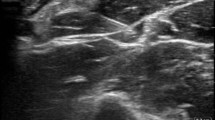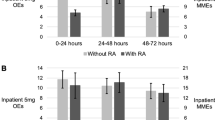Abstract
Purpose
To determine if regional anesthesia had added benefit to general anesthesia, with or without local anesthesia, in controlling post-operative pain in outpatient orthopedic trauma surgery.
Methods
A retrospective review was performed of prospectively gathered data on 71 patients undergoing outpatient orthopedic trauma surgery. All patients received general anesthesia and an addition 52 patients received additional regional anesthesia. Regional vs. no regional anesthesia groups were compared in terms of post-anesthesia care unit (PACU) pain visual analog scores (VAS), PACU length of stay (LOS), opioid use, and pain control at two weeks.
Results
The regional anesthesia group not differ in demographics or proportion of patients receiving local anesthesia, but was less likely to be undergoing major procedures (13% vs. 37%, proportional difference (PD) − 23%; 95% confidence interval (CI) − 46% to − 0.4%). There were no detectable differences in PACU opioid requirements (median difference (MD) − 7.5 mg, CI − 8 to 0), PACU LOS (MD − 13 min, CI − 63 to 24), discharge pain VAS (MD 0, CI − 1 to 1), post-discharge pain VAS (MD 0, CI − 1 to 1), opioid refills (PD − 6%, CI − 31% to 18%), or patient-perceived pain control (PD − 24%, CI − 41% to 0%). On multivariate analysis, regional anesthesia was the only variable negatively associated with patient-perceived pain control at two weeks (Odds Ratio 0.15; 95% CI 0.03 to 0.8).
Conclusions
Regional anesthesia did not improve post-operative opioid requirements, PACU LOS, or patient-reported pain in the immediate or short-term post-operative period.
Similar content being viewed by others
Availability of data and material
The datasets used and/or analyzed during the current study are available from the corresponding author on reasonable request. All data generated or analyzed during this study are included in this published article.
References
Ludwin DB (2014) Setting up an ambulatory regional anesthesia program for orthopedic surgery. Anesthesiol Clin 32(4):911–921
Kopp SL, Horlocker TT (2010) Regional anaesthesia in day-stay and short-stay surgery. Anaesthesia 65(s1):84–96
Stein BE, Srikumaran U, Tan EW, Freehill MT, Wilckens JH (2012) Lower-extremity peripheral nerve blocks in the perioperative pain management of orthopaedic patients: AAOS exhibit selection. J bone joint surg Am vol 94(22):e167
White PF, Issioui T, Skrivanek GD, Early JS, Wakefield C (2003) The use of a continuous popliteal sciatic nerve block after surgery involving the foot and ankle: does it improve the quality of recovery? Anesth Analg 97(5):1303–1309
McLeod DH, Wong DH, Vaghadia H, Claridge RJ, Merrick PM (1995) Lateral popliteal sciatic nerve block compared with ankle block for analgesia following foot surgery. Can J anaesth 42(9):765–769
Goldstein RY, Montero N, Jain SK, Egol KA, Tejwani NC (2012) Efficacy of popliteal block in postoperative pain control after ankle fracture fixation: a prospective randomized study. J Orthop Trauma 26(10):557–561
Rongstad K, Mann RA, Prieskorn D, Nichelson S, Horton G (1996) Popliteal sciatic nerve block for postoperative analgesia. Foot Ankle Int 17(7):378–382
Mendicino RW, Statler TK, Catanzariti AR (2002) Popliteal sciatic nerve blocks after foot and ankle surgery: an adjunct to postoperative analgesia. J foot ankle surg 41(5):338–341
O’Donnell BD, Ryan H, O’Sullivan O, Iohom G (2009) Ultrasound-guided axillary brachial plexus block with 20 milliliters local anesthetic mixture versus general anesthesia for upper limb trauma surgery: an observer-blinded, prospective, randomized, controlled trial. Anesth Analg 109(1):279–283
Klein SM, Evans H, Nielsen KC, Tucker MS, Warner DS, Steele SM (2005) Peripheral nerve block techniques for ambulatory surgery. Anesth Analg 101(6):1663–1676
Dingemans SA, de Ruiter KJ, Birnie MFN, Goslings JC, van Samkar G, Schepers T (2017) Comparable postoperative pain levels using 2 different nerve blocks in the operative treatment of displaced intra-articular calcaneal fractures. Foot Ankle Int 38(12):1352–1356
Russell DF, Pillai A, Kumar CS (2014) Safety and efficacy of forefoot surgery under ankle block anaesthesia. Scott Med J 59(2):103–107
Elliot R, Pearce CJ, Seifert C, Calder JD (2010) Continuous infusion versus single bolus popliteal block following major ankle and hindfoot surgery: a prospective, randomized trial. Foot Ankle Int 31(12):1043–1047
Li YS, Chen CY, Lin KC, Tarng YW, Hsu CJ, Chang WN (2019) Open reduction and internal fixation of ankle fracture using wide-awake local anaesthesia no tourniquet technique. Injury 50(4):990–994
Grosser DM, Herr MJ, Claridge RJ, Barker LG (2007) Preoperative lateral popliteal nerve block for intraoperative and postoperative pain control in elective foot and ankle surgery: a prospective analysis. Foot Ankle Int 28(12):1271–1275
Ringrose NH, Cross MJ (1984) Femoral nerve block in knee joint surgery. Am J Sports Med 12(5):398–402
Ejlersen E, Andersen HB, Eliasen K, Mogensen T (1992) A Comparison Between preincisional and postincisional lidocaine infiltration and postoperative pain. Anesth Analg 74(4):495–498
Bach S, Noreng MF, Tjellden NU (1988) Phantom limb pain in amputees during the first 12 months following limb amputation, after preoperative lumbar epidural blockade. Pain 33(3):297–301
Coderre TJ, Vaccarino AL, Melzack R (1990) Central nervous system plasticity in the tonic pain response to subcutaneous formalin injection. Brain Res 535(1):155–158
Hsu JR, Mir H, Wally MK, Seymour RB (2019) Clinical Practice guidelines for pain management in acute musculoskeletal injury. J Orthop Trauma 33(5):e158–e182
Jaynstein J, Donnell A, Chambers L, Mauffrey C, Parry JA (2020) The effect of surgical pain severity, preoperative opioid use and patient characteristics on postoperative opioid prescriptions and refills in orthopedic surgery. Eur J Orthop Surg Traumatol 30(5):781–787
Clark L, Robinson M, Varbanova M (2014) Role of regional anesthesia in orthopedic trauma. Anesthesiol Clin 32(4):789–808
Memtsoudis GS, Sun SX, Chiu EY-L et al (2013) Perioperative comparative effectiveness of anesthetic technique in orthopedic patients. Anesthesiology. 118(5):1046–1058
Hunt KJ, Higgins TF, Carlston CV, Swenson JR, McEachern JE, Beals TC (2010) Continuous peripheral nerve blockade as postoperative analgesia for open treatment of calcaneal fractures. J Orthop Trauma 24(3):148–155
Liu SS, Strodtbeck WM, Richman JM, Wu CL (2005) A comparison of regional versus general anesthesia for ambulatory anesthesia: a meta-analysis of randomized controlled trials. Anesth Analg 101(6):1634–1642
Namdari S, Nicholson T, Abboud J, Lazarus M, Steinberg D, Williams G (2017) Randomized controlled trial of interscalene block compared with injectable liposomal bupivacaine in shoulder arthroplasty. J Bone Joint Surg Am 99(7):550–556
Hu B, Lin T, Yan SG et al (2016) Local infiltration analgesia versus regional blockade for postoperative analgesia in total knee arthroplasty: a meta-analysis of randomized controlled trials. Pain Physician 19(4):205–214
Elkassabany N, Cai LF, Mehta S et al (2015) Does regional anesthesia improve the quality of postoperative pain management and the quality of recovery in patients undergoing operative repair of tibia and ankle fractures? J Orthop Trauma 29(9):404–409
Jeon Y-T (2012) Peripheral nerve block for anesthesia in patients having knee arthroplasty. Korean J Anesthesiol 62(5):403–404
Affas F, Nygårds EB, Stiller CO, Wretenberg P, Olofsson C (2011) Pain control after total knee arthroplasty: a randomized trial comparing local infiltration anesthesia and continuous femoral block. Acta Orthop 82(4):441–447
Spangehl MJ, Clarke HD, Hentz JG, Misra L, Blocher JL, Seamans DP (2015) The Chitranjan Ranawat Award: Periarticular injections and femoral & sciatic blocks provide similar pain relief after TKA: a randomized clinical trial. Clin Orthop Relat Res 473(1):45–53
Funding
No funding was required for the currently submitted project.
Author information
Authors and Affiliations
Contributions
DGD, CM, and JAP contributed to conception and design of the study. DGD and LC collected data and organized the database. JAP performed the statistical analysis. DGD wrote the first draft of the manuscript. All authors contributed to manuscript revision, read, and approved the submitted version.
Corresponding author
Ethics declarations
Conflicts of interest
The authors declare that they do not have any conflict of interest.
Ethics approval
This study was approved by our institutional review board.
Additional information
Publisher's Note
Springer Nature remains neutral with regard to jurisdictional claims in published maps and institutional affiliations.
Rights and permissions
About this article
Cite this article
Douleh, D.G., Chambers, L. & Parry, J.A. The effect of regional anesthesia blocks on post-operative pain after ambulatory orthopedic trauma surgery. Eur J Orthop Surg Traumatol 32, 1201–1206 (2022). https://doi.org/10.1007/s00590-021-03079-w
Received:
Accepted:
Published:
Issue Date:
DOI: https://doi.org/10.1007/s00590-021-03079-w




